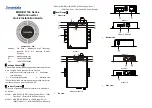
267
scale is the output scale factor
T is the time between samples
Since the resultant math waveform is an integral waveform, its vertical scale is in volt-seconds (its
horizontal scale is in seconds). The source signal is integrated over its entire record length;
therefore, the math waveform record length equals that of the source waveform.
Offset and Position
. When creating integrated math waveforms from live channel waveforms,
consider the following:
You should scale and position the source waveform so that it is contained on screen. (Off
screen waveforms may be clipped, which will result in errors in the integral waveform).
You can use vertical position and vertical offset to position your source waveform. The
vertical position and vertical offset will not affect your integral waveform unless you position
the source waveform off screen so that it is clipped.
DC Offset
. The source waveforms that you connect to the instrument often have a DC offset
component. The instrument integrates this offset along with the time-varying portions of your
waveform. Even a few divisions of offset in the source waveform may be enough to ensure that
the integral waveform saturates (clips), especially with long record lengths.
Defining Spectral Math Waveforms
The math capabilities of the instrument include waveform spectral analysis. This section describes
how you can control the analysis intuitively with time domain and frequency domain controls.
These controls merge the time domain controls with the frequency domain controls to provide a
complete spectral analyzer.
Signals may be represented by their characteristics in both the time and the frequency domain. By
combining and transforming source waveforms into spectral math waveforms, you can
simultaneously view signal characteristics in both domains.
This spectral analyzer provides a complete set of controls and features that allow you to make time
and frequency domain measurements without the need to learn extensive details about FFT
algorithms.
Frequency Domain Controls
: Use traditional spectrum analyzer controls to set the center
frequency, span, and resolution bandwidth directly.
Time Domain Controls
: The time domain controls for the acquired waveform set the time
duration and the resolution (time between samples). You can easily set the required sample
rate and record length.
Gating Controls
: These controls are the bridge that connects the time domain to the
frequency domain. You can perform spectral analysis on a gated region of the input
waveform. This gating also determines the resolution bandwidth.
Window Functions
: Eight different window functions are available to shape the filter
response.
Magnitude Versus Frequency
: Display log data in dB, dBm, or linear mode. You can
display the real or imaginary parts of the spectral magnitude only. Reference level offset and
reference level controls give complete control over the vertical position and offset of the
spectrum.
Phase Versus Frequency
: Display phase data as a function of frequency in radians or
degrees. You may zero the noise phase for magnitudes below a threshold level. Finally, you
may select Phase unwrap and dq/dw, group delay.
Summary of Contents for TDS5000B Series
Page 36: ...36 AFTDS Differential Signal Adapter...
Page 280: ...280 Blackman Harris window...
















































